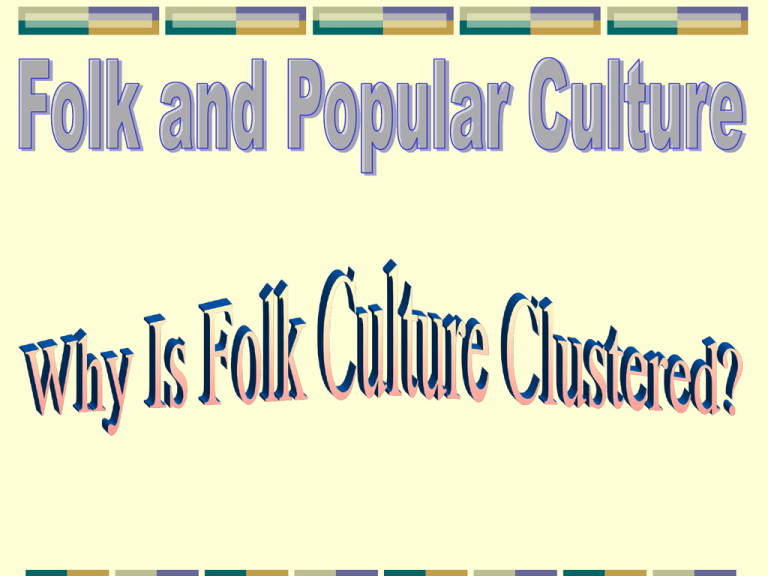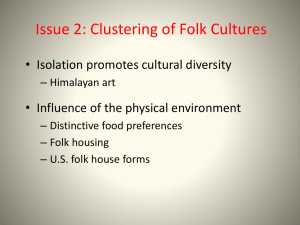
A groups unique folk customs develop through centuries of relative
isolation from customs practiced by other culture groups
Folk customs observed at a point in time vary widely from one place
to another, even nearby places
Himalayan Art
Geographers P. Karan and Cotton Mather studied a 1500 mile corridor
in the Himalayan Mountains
-found 4 distinct culture groups
1. Buddhists (southern Tibet, China)
2. Muslims (eastern Pakistan)
3. Hindu (northern India)
4. Anamists (Myanmar, near Bhutan)
They studied art from
each group and found
distinct elements in each
groups artistic subjects
They found unique
customs among these
groups in art as well as
dance, music,
architecture, and crafts
Influence of the Physical
Environment
The idea of environmental
determinism is that the environment
causes social customs
Modern geographers reject this idea
because many different peoples live in
similar environments but adopt distinct
social customs
Also, examples exist of people living
in different environments who adopt
similar social customs
*The environment is only one of
several controls over social customs
The environment can influence certain elements of society such as
food, clothing, and shelter
-Arctic residents wear fur-lined boots for protection against the cold
-people living in warm, humid climates may not wear any shoes
-the Dutch wear wooden shoes because the wood is waterproof and
much of that country’s farmland is often wet
*folk societies are particularly responsive to the environment
because of their low level of technology and prevailing agricultural
economy
-folk cultures are extremely diverse, even if found in similar
environments
-not all residents in wet environments wear wooden shoes
Distinctive Food Preferences
Folk food habits also derive from the environment
Humans need to consider the environment when deciding what foods
to produce (soil, climate, terrain, vegetation, rice or wheat)
-rice demands a mild, moist climate
-wheat grows in colder, drier climates
People adopt their food preferences to environmental conditions
Soybeans: toxic in their raw state, but excellent protein when cooked
In Asia, fuel sources are scarce
So, Asians use soybeans in many of their foods
-soy meal requires less cooking than other foods
In Italy, quick frying foods became popular partly because of wood
shortages
In northern Europe, abundant wood supply allowed for longer cooking
(slow-roasted) foods
Food habits are strongly influenced by cultural traditions
What a group of people eat often helps to determine social, religious,
and ethnic characteristics
*the surest way to identify a family’s ethnic origins is to look in its
kitchen
Even after a group moves and their dress, manners, and speech
become indistinguishable in their new culture, old food habits are one
of the last traditional folk customs held onto
Folk customs believe that
everything in nature carries a
distinctive characteristic
-so, people may desire
or avoid certain foods
Certain foods are eaten because they are perceived to enhance desirable
qualities
Abipone Indians (Paraguay) eat jaguars because they believe it
will make them strong, brave, and swift
The mandrake plant of the Mediterranean area is thought to enhance the
power of love
People also refuse to eat certain foods thought to have negative
environmental connotations
Taboo—behavior restrictions of a society based on social customs
The Ainu people of Japan refuse to eat otter because they are believed to
be forgetful and consuming them could cause memory loss
Most mainland Europeans felt potatoes were to blame for ailments such
as typhoid, tuberculosis, and famine
Mbumkpov women of Chad refuse to eat goat or chicken before
becoming pregnant
-thought this takes away pain during child birth
Trobriand Islands off of eastern Papua New Guinea—couples are
prohibited from eating meals together before marriage
-premarital sex is accepted by this society
Most food avoidance
customs arise from
cultural values rather
than from environmental
factors
Well-known food taboos are found in the Bible
Hebrews were prohibited from eating pork
-partially a result of environmental concern
--pigs were not suitable for the pastoral nomad lifestyle of the
Hebrews, and its meat spoils quickly in the warm Mediterranean
climate
Muslims also have a pork taboo
-also in part environmental
-pigs are not suitable for the dry Arabian Peninsula climate
-pigs would compete with humans for food, and would not be
able to carry loads, pull a plow, or provide milk or wool
-raising pigs in Arabia would be an ecological disaster
Hindus also have a taboo against
consuming cows
-also traced partially to environment
-cows are the source of oxen (castrated
male bovine)
-when the monsoon rains come, every
field in India needs to be quickly
plowed
-so a very large supply of oxen are
needed
*Although these taboos are partially
environmental, they cannot be
explained only by environmental
factors*
Social values also have an important role in taboos
-because people in similar climates with similar income levels
consume different foods
Food taboos are also found in cultures dominated by popular culture
-in US, Americans do not eat insects, although they are very high
in nutritional value
-Thailand and Myanmar—they deep-fry and ground giant water
bugs into their foods for nutrition
-Americans do eat canned tomatoes and mushrooms which often
contain insects (although this is not commonly acknowledged)
Folk Housing
The house is a good reflection of cultural heritage, current fashion,
functional needs, and the impact of environment
The type of building materials used to construct houses is partially
influenced by environmental resources
-the lack of trees in the Great Plains region of North America
caused many American settlers to build sod homes
Two most common building materials in the world:
1. Wood
2. Brick
Stone, grass, sod, and skins also used
Wood is the preferred material
-but less expensive materials may be substituted
--using drywall instead of wood for interior walls
The orientation of houses can vary between societies
Fiji—eastern wall is considered sacred
China—northwest wall considered sacred
Madagascar—homes also have religious considerations
-main door always faces west
-north wall honors ancestors
-beds placed against east wall, heads point north
Java—front door always faces south
-South Sea goddess holds key to the Earth
Housing forms are related to environmental and social conditions
-pitched roofs needed to facilitate runoff in wet or snowy
climates
-windows face south in temperate climates for aid in heating
-windows are smaller in hot climates
U.S. Folk House Forms
Older homes in the U.S. display local folk-culture customs
-as pioneers moved westward during the 1700s and 1800s, they
cut trees to build their houses, barns, and fences
-the style of pioneer homes reflected whatever upscale style was
prevailing at the place on the East Coast from which the family
migrated from
-houses built in the U.S. in the past 50 years display popular
culture influences
Three Major Folk Housing Culture Hearths:
1. New England—migrants brought their house types west through the
Great Lakes region and into Wisconsin
2. mid-Atlantic—migrants brought their housing styles through the
Ohio River Valley and through Appalachia
3. Lower Chesapeake—migrants moved southward along the east coast
-basements are more likely to be found in northeastern homes than in
southwestern homes












